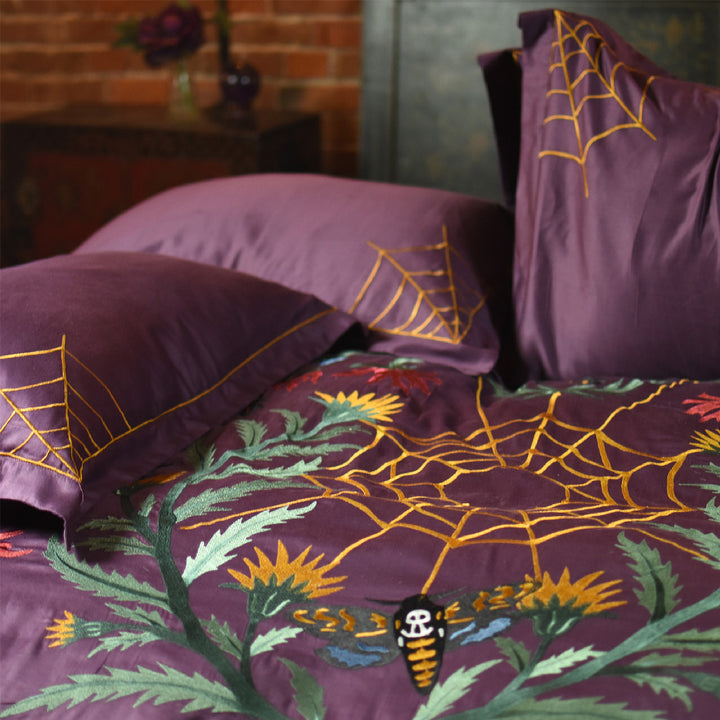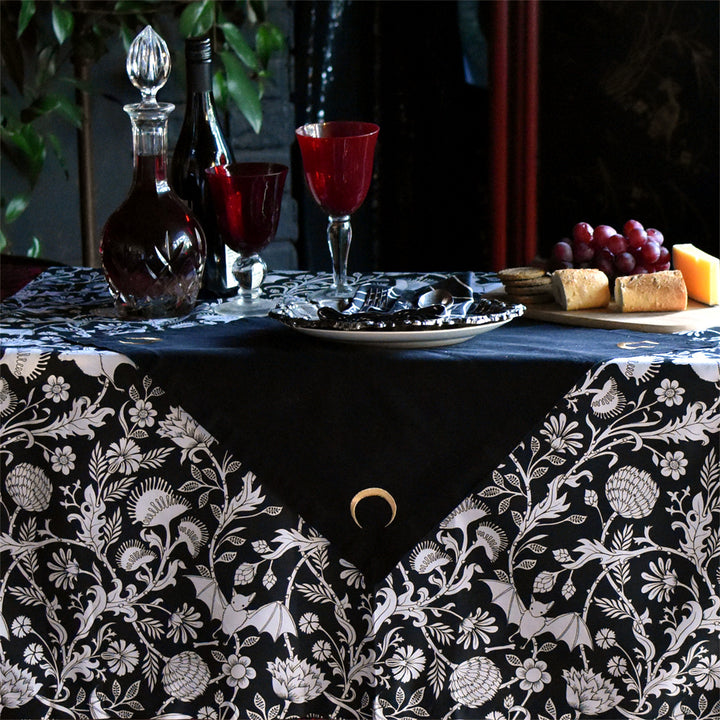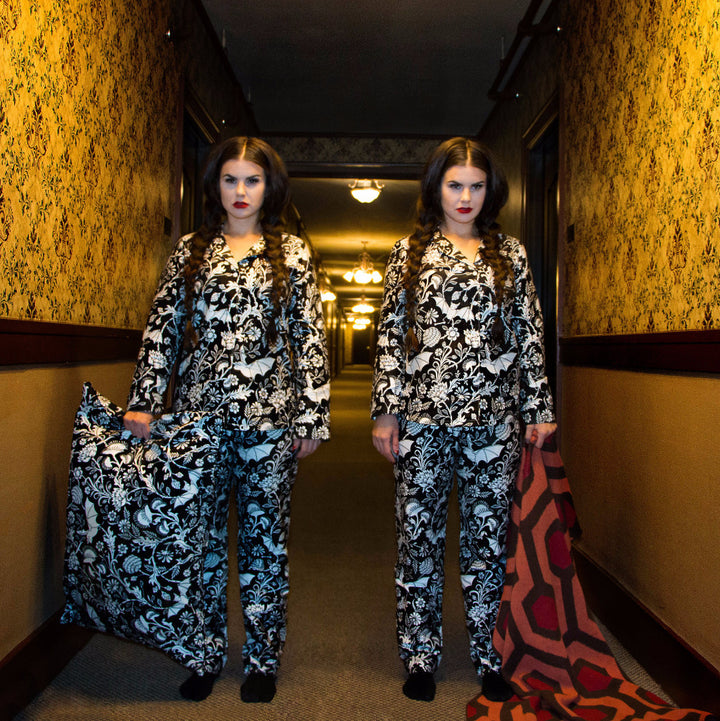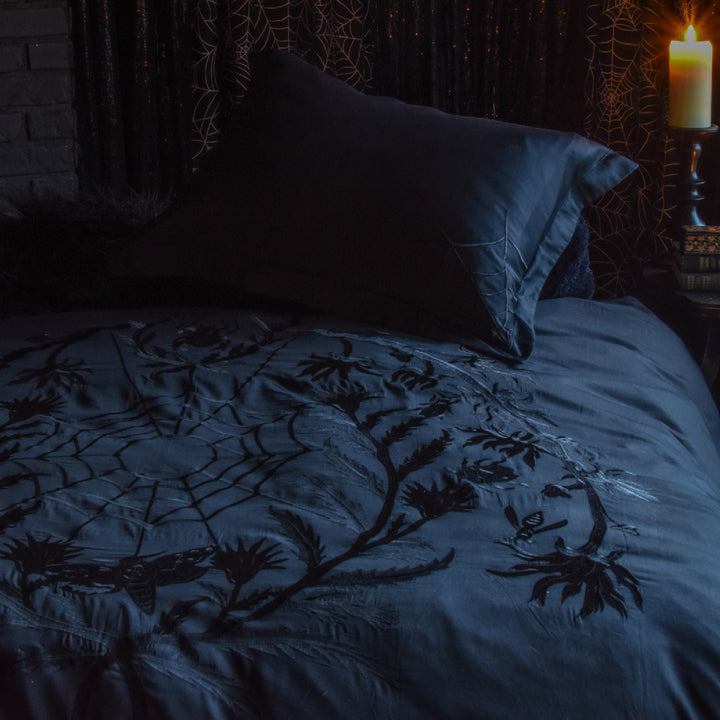What Is Velvet?

Definition: Velvet is a woven fabric known for its dense, short pile that creates a smooth, soft surface with a subtle glow. Once crafted exclusively from silk, velvet now includes modern materials like viscose and cotton, offering a luxurious texture steeped in history and expressive design.
Characteristics: Velvet captures light in unpredictable ways, giving it a rippling surface that shimmers with every angle shift. It feels rich and adds a moody, immersive quality to any space.
Examples:
- The Emerald Damask Velvet Curtain layers baroque motifs over emerald-toned crushed velvet that adds a regal touch to interiors.
- The Black Velvet Duvet Cover cloaks the bed in shadowy elegance, creating a personal retreat with depth, texture, and atmosphere.
- The Black Velvet Bats Curtains and Valances merge gothic patterning with velvet’s lush finish, making them a striking choice for those who embrace dramatic interiors.
Interesting Fact: During the Renaissance, velvet symbolized wealth and exclusivity. Nobility across Europe wore velvet robes, capes, and gowns embroidered with gold or silver thread, while royal courts used the fabric for thrones, ceremonial banners, and wall hangings. In 16th-century England, Queen Elizabeth I even enforced sumptuary laws that restricted velvet to high-ranking nobility, further cementing its role as a fabric of status.
The Texture and Appeal of Velvet
Velvet has shaped interiors for centuries, not only through its tactile beauty but also through the atmosphere it creates. Designers and artists have long used the fabric to bring depth into a room, knowing that velvet doesn’t sit quietly in the background. That presence comes from the fabric's response to light, movement, and touch. For example, velvet transforms flat surfaces into dynamic ones as light shifts across ridges, creating a visual rhythm that draws the eye.
Crushed velvet creates contrast in interior spaces by layering softness over stark or sterile elements. A bare window framed by plain walls can feel cold or unfinished, but introducing a curtain with weight and texture shifts the balance. The Gold Velvet Curtain adds warmth and saturation to the space, softening harsh lines and reflecting ambient light in a way that feels both rich and grounded.
Velvet vs. Other Fabrics: A Comparison
Let's compare this lush fabric, specifically crushed velvet, with other popular textiles like bamboo and cotton and discover why velvet stands out in Sin in Linen’s luxurious lineup.
Bamboo
Bamboo fabric offers softness with high breathability. The surface feels clean and calm, making it especially appealing for bedding in warm environments. The material hangs with a natural flow that suits relaxing spaces. Beyond its tactile quality, bamboo fabric is highly versatile. It can hold its own in modern minimalist spaces as much as in dark maximalist ones. We offer an array of jewel-toned bamboo bedding made to tie your space together (and keep you cool).
Cotton
Cotton adds quiet stability. The surface absorbs light rather than reflecting it, which helps ground a space that might otherwise feel too sharp or overdesigned. Cotton can feel structured or soft depending on the weave, and that versatility makes it one of the most adaptable fabrics in home decor. It works well as a base layer in bedding, upholstery, or window treatments. The fabric holds its shape, washes cleanly, and supports function and form. Around here, we also adore its ability to take on rich hues and patterns. It’s a familiar favorite that makes the perfect foundation for our unique bedding, from Victorian Gothic to whimsical designs.
Velvet in Gothic and Alternative Aesthetics
Crushed velvet belongs in gothic interiors because it embodies everything the aesthetic demands: drama, texture, depth, and timeless grandeur. Historically, velvet carried centuries of visual authority. In Renaissance Europe, velvet-lined thrones wrapped nobility in layers of dyed silk and appeared in religious vestments as prestigious marks. The fabric signaled power through rarity and richness.
When used in modern gothic interiors, those historical roots resurface not as strict replication but as texture-driven design choices. Deep green drapes or onyx-toned bedding can absorb excess light and sharpen architectural details. A black crushed velvet curtain draws the eye toward windows and entryways, grounding the space with texture while deepening the shadows that define a room’s mood. When paired with iron fixtures, candlelit corners, or raw wood accents, velvet contrasts these elements in a balanced and deliberate way.
Caring for Your Velvet Items
Velvet is incredible for all the reasons mentioned, but it requires thoughtful care. Proper care preserves the fabric’s shape, finish, and weight. Here’s how to maintain the look and feel of velvet without compromising its character:
- Shake out dust regularly: Gently lift and shake the fabric to release trapped dust from the folds and surface. This small act keeps the texture from dulling over time and helps prevent buildup in areas where the material drapes or gathers.
- Spot clean with a damp cloth: Use a soft, wet cloth to blot stains or marks gently. Harsh scrubbing can flatten the texture and leave visible surface disruptions.
- Add mild soap for stubborn areas: For stubborn spots, mix a small amount of gentle soap with cool water. This method works best for oils, cosmetics, or other heavier stains that won’t lift with water alone.
- Air dry naturally: Lay the fabric flat or hang it in a shaded, well-ventilated space after cleaning. Avoid heat sources, radiators, or sunlight, which can warp the texture and fade deeper colors.
- Use steam to revive the texture: A steamer helps lift and reset the fabric’s surface after storage or cleaning. Hold the steamer above the material and let the vapor soften the texture without soaking it.
- Store with care: When not used, fold the fabric loosely or hang it in a breathable garment bag. Avoid plastic coverings or tightly packed drawers, which can press the texture flat over time.
Read more:
- How to Create a Romantic Bedroom: Design Tips for An Intimate Space
- How To Achieve A Timeless Gothic Interior Design In Your Home
- Everything You Need To Know About Bamboo Sheets And Their Benefits
Frequently Asked Questions About Velvet
Why is velvet considered luxurious?
Velvet's sumptuous texture and unique finish give it an unmatched richness, making it an icon of luxury and sophistication. Historically associated with royalty and high society, its dense and plush fabric exudes opulence and adds a distinct charm to any decor.
How can you tell if velvet is real or synthetic?
Real velvet is woven from natural fibers like cotton or bamboo and has a soft, smooth pile that catches light beautifully. Synthetic velvet, often made from polyester or nylon, offers a similar look at a lower price but lacks some of its natural counterpart's luster and tactile quality. A simple touch test can often reveal the difference: real velvet feels warmer and more luxurious.
How should velvet be stored?
Store velvet in a cool, dry place away from direct sunlight to prevent fading and damage. Hanging velvet items can preserve their shape, but use padded hangers to avoid impressions. For delicate pieces like bedding or robes, consider safely folding them and using acid-free tissue paper to reduce creasing.
Can velvet be ironed or steamed?
Ironing velvet directly is a risky move and can flatten its pile. Instead, gently steaming velvet can safely remove minor wrinkles. Hold the steamer at a distance to avoid soaking the fabric, allowing steam to relax the fibers without direct contact.
Is velvet suitable for upholstery?
Absolutely! Velvet transforms furniture into statement pieces with its lush texture and bold finish. Perfect for adding a touch of drama to any room, velvet upholstery can endure daily wear if approached with care. Opt for durable blends that withstand use, bringing a touch of Sin in Linen's creative chaos into your living space.
What is the history of velvet?
Velvet's enchanting history dates back to ancient Egypt and China, with Europe embracing it by the Middle Ages. A coveted fabric for nobility and royalty, velvet has traversed centuries, ever draping itself in the mystery and grandeur that your bold personal universe craves today.
What is the best way to remove wrinkles from velvet?
Fabric steaming reigns supreme for stubborn wrinkles. Employ a handheld steamer, ensuring you gently pulse steam across the item while maintaining a safe distance. This method revives the plush perfection of velvet without compromising its glossy essence.










































Leave a comment